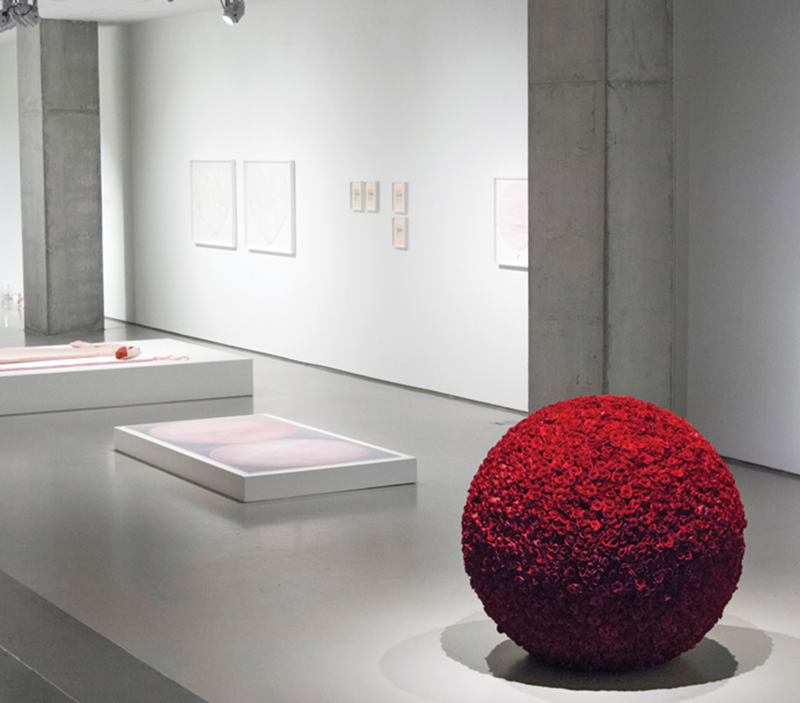
How does an artist simultaneously perform the sometimes-contradictory role of curator, sensitively arranging their own artwork within the framework of an institution, while being deliberately transparent about the slipperiness of holding both roles?
Chicago-based artist, writer and “sometimes curator” Matt Morris poses that question and more in his exhibition currently on view at the Contemporary Arts Center titled The Perfect Kiss (QQ)* *questioning, queer. In it, Morris pairs his own recent artistic investigations alongside the personal ephemera, artwork and correspondences of deceased sculptural installation and performance artist James Lee Byars.
Morris aims to consider the ways in which often behind-the-scenes performers within the art institution craft archives and historical narratives, and he coyly implicates himself as an instrument of the museum — hinting at a larger two-step his curatorial practice takes between art historical and personal truths.
Byars’ lifelong quest for beauty and perfection coupled with a mysterious personal life make him a compelling subject to play foil to Morris’ more confessional and self-reflexive works. To that aim, the fast-speaking, eloquent Morris admits that he shaved off massive parts of Byars’ practice for The Perfect Kiss.
Compared to some of the more recent surveys of Byars’ work (particularly last year’s MoMA PS1 retrospective and a gallery show with Anish Kapoor in Paris), Morris says, “I decided to really focus on a ribbon moving through the work that is — at best — always secondary in the way that his practice is shown. I prefer the tender, the fragile, the non-monolithic, the interpersonal.”
And so, with that guiding spirit, Morris deliberately sought out many of Byars’ less-canonical works. In fact, The Perfect Kiss features a more nuanced approach to what can be seen as art objects within a gallery context — and that is part of Morris’ curatorial aim.
Several of Byars’ personal/professional correspondences written in elaborate, sometimes nearly indecipherable handwriting are scattered throughout the exhibition. Fragile, crumbled pink tissue paper rolls are bathed in soft light and honored with monumental gallery pedestals — an act Morris calls “a pretty queer gesture.”
There are a number of correspondences in the show to curators, gallerists and collectors, whom Byars wrote to constantly, and the letters read coyly flirtatious and flattering — especially considering that the content of many were layout plans and gallery specifications. These intimate glimpses into the relationships the artist was cultivating among his art-world peers acts as a mirror for the interpersonal issues Morris is trying to tease out for the visitor.
Featured in The Perfect Kiss is a photograph of Byars in his studio wearing pink silk pajamas, a top hat and a pink veil covering his face that Morris says “speaks volumes about his position,” and it gets to the heart of that questioning, queer in the exhibition title.
On one hand, Byars wrote daily love letters (sometimes on penis-shaped paper) to artist Joseph Beuys. He was married to a woman with whom he rarely ever lived in the same country and was known for his outlandishly dandyish aesthetic. At the same time, Byars remained intensely private about his love life.
Morris insists, however, that he is not interested in detailing what kind of sex Byars had. “I’m more interested in how did he express or reserve his desire and where did that come up, both in his private life but also in the art world,” he says. And few if any curators before Morris have even skirted the question of Byars’ sexuality.
In another Byars’ piece, four single, ambiguously defined words — “behind, rose/these, dad/and, top” — written in silver pencil on tan paper are selected out of a 14-page correspondence (one word on each), demonstrating for Morris the arbitrary nature of crafting a narrative about an artist through their work.
In an effort to reveal his hand and drag in traces of the curating/installation process, Morris included silver registration marks on the wall where those other ten words from the aforementioned letter would have been.
Morris also photographed a scene during the installation of one of the CAC’s preparators wearing Byars’ pink tail and nothing else, (“I’ll be wearing ribbons down my back this summer”), allowing the viewer an intimate glimpse into the exhibit’s creation and the awareness that they are standing in a space with and among objects that speak to a prior personal, as well as institutional, history.
The most canonical of Byars’ works in the show, “The Rose Table of Perfect,” is a spherical living sculpture of 3,333 red roses, for which Morris admits he “barely touched a rose,” enlisting gallery assistants from the Art Academy of Cincinnati to create the piece to Byars’ specifications.
In striking contrast, Morris’ “Festoon Drape” panels adorn the main entrance (one is only viewable from the Members’ Lounge), for which the artist labored over for months.
“They take a lot,” Morris says of the process to create these flouncy, smoky-grey translucent curtains. “They came from a place that I really needed to give something of myself.”
And the subtitle, (“for James, Robert, Zaha, Steven, and Eric”), attests to Morris’ concerns for the relationships he is cultivating in his own life, as they are named for his own personal pantheon of art-world muses.
The labels throughout are a treasure trove of poetic, biographical and art historical nuggets to uncover. One of Morris’ installations is an aptly named “archive VI” of empty vases, the label for which features the detailed provenance of every person he received flowers from, and for what occasions. Much like Byars’ overwhelming correspondences, here Morris too is writing his own personal narrative into the institutional history of the exhibition.
“There’s this sort of murky position of artist as curator,” Morris says. “It’s a little taboo — it’s a little gauche.” But he concedes that the word is becoming more fraught thanks to its overuse in the marketplace.
“I think it puts a pressure on the way the word ‘curate’ is being used now,” he says. “People are curating dinner parties and curating DJ lists. And so I think this tries to put my nimble faggoty toe into that issue and perform it, but maybe, hopefully, perform it a little critically.”
In this way, Morris performs a tricky pas de deux that interweaves the personal history of artists with the responsibilities of curators and other gatekeepers of our cultural institutions.
THE PERFECT KISS (QQ)* *QUESTIONING, QUEER continues at the Contemporary Arts Center through Oct. 11. The CAC presents a lecture by Gordon Hall in conjunction with the exhibit Thursday. More info: contemporaryartscenter.org.





